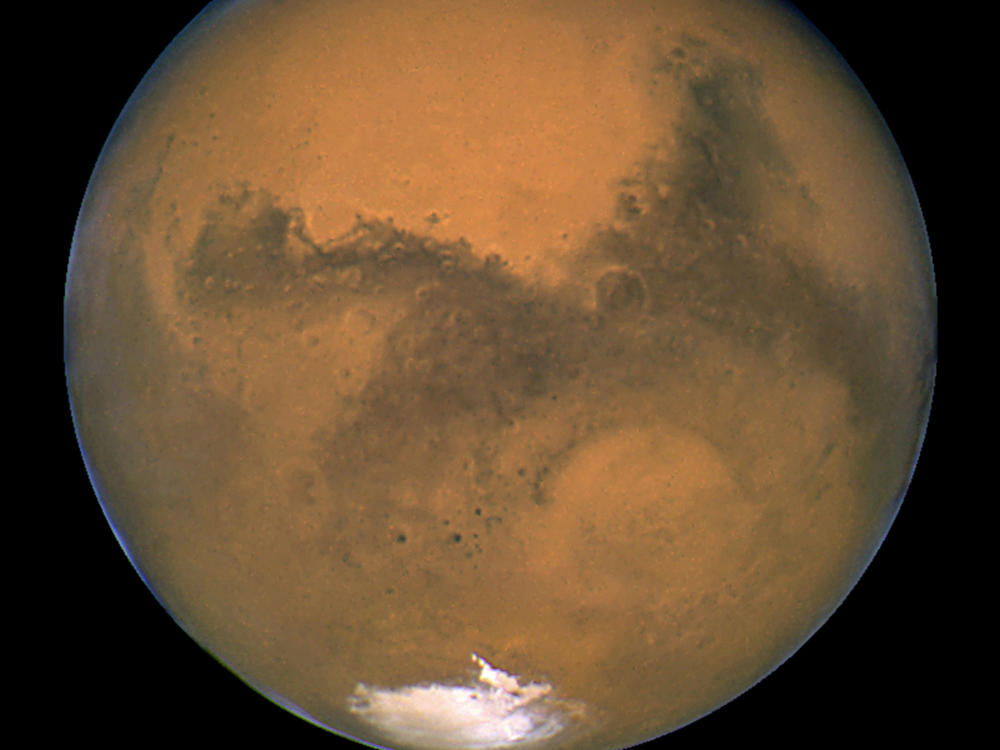GHSA 6A Boys Basketball Championships: Wheeler High School vs Newton High School starts at 7:30 p.m.
Section Branding
Header Content
Mars Had Liquid Water On Its Surface. Here's Why Scientists Think It Vanished
Primary Content
All evidence points to the fact that Mars once had flowing water, but numerous flybys, orbiters, landers and rovers have confirmed one undeniable fact — any liquid water that was once on its surface is now long gone.
A study out of Washington University in St. Louis might have found the reason: Mars, which is about half the size of Earth, and just over one-tenth the mass of our own watery world, might just be too small.
One idea, the Mars Ocean Hypothesis, suggests that Mars not only had some liquid water, but a lot of it. But the new study's co-author Kun Wang says his team's finding, which was published this week in the Proceedings of the National Academy of Sciences, pours cold water on that notion.
"Mars' fate was decided from the beginning," Wang, an assistant professor of Earth and planetary sciences, said in a statement. "There is likely a threshold on the size requirements of rocky planets to retain enough water to enable habitability and plate tectonics."
That's because the lower mass and gravity of Mars makes it easier for volatile elements and compounds such as water to escape from its surface into space.
Led by Zhen Tian, a graduate student in Wang's laboratory, the researchers looked at 20 Martian meteorites ranging in age from about 200 million years old to 4 billion years, dating to a time when the solar system was still in the chaos of formation.
The researchers analyzed a somewhat volatile element — potassium — to help understand how water would have behaved on the surface of Mars.
Speaking to NPR, Wang said the team measured the ratio of two isotopes of potassium — potassium-39 and potassium-41 — in the meteorites. In lower gravity environments, such as Mars, the potassium-39 is more easily lost to space, leaving behind a higher ratio of the heavier isotope, potassium-41. Water behaves in much the same way, indicating that most of it would have been lost to space during the formation of Mars.
It's something Wang and his colleagues saw even in the oldest meteorites, suggesting that this was an issue for Martian water right from the beginning.
The team also looked at samples from the moon and from an asteroid, both much smaller and drier than either Earth or Mars, to study the potassium isotopes in them. They found a direct correlation between mass and the volatiles — or lack thereof — in the samples.
The liquid water that did remain on the Martian surface carved out the now-desiccated canyons, riverbeds and other formations that we see there today, Wang says. But that water, too, would likely have disappeared had it not been trapped as ice at the Martian poles as the climate on the planet became colder, he notes.
The findings could help refine the search for habitable exoplanets
The research has implications outside of our solar system, too. As scientists hunt for planets around other stars, the holy grail of their quest is to find those capable of supporting life — which means neither too hot nor too cold.
Even if a planet orbits its star in the so-called Goldilocks Zone, at just the right distance to be warm enough for liquid water without being too hot to support life, it could still be too small to keep hold of the water.
"This does probably indicate a lower limit on size for a planet to be truly habitable," Bruce Macintosh, deputy director of Stanford University's Kavli Institute for Particle Physics and Cosmology, tells NPR. "Understanding that lower limit is important — there are lines of evidence that small planets are more common than big ones, so if the small ones are dry, then there are fewer potentially habitable worlds out there than we thought."
He adds, however, that only "the most optimistic exoplanet astronomers" would currently list a Mars-size exoplanet as a candidate for habitability.
Copyright 2021 NPR. To see more, visit https://www.npr.org.
Bottom Content

